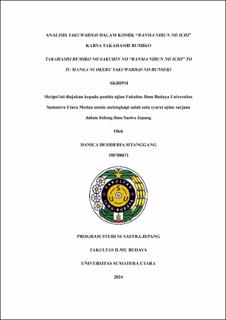Analisis Yakuwarigo dalam Komik “Ranma Nibun No Ichi” Karya Takahashi Rumiko Takahashi Rumiko No Sakuhin No “Ranma Nibun No Ichi” To Iu Manga Ni Okeru Yakuwarigo No Bunseki
Analysis of Yakuwarigo in the Comic 'Ranma Nibun No Ichi' by Takahashi Rumiko

Date
2024Author
Sitanggang, Danica Desideria
Advisor(s)
Malayu, Siti Muharami
Alimansyar
Metadata
Show full item recordAbstract
This research discussed the analysis of yakuwarigo in the comic 'Ranma Nibun No Ichi' by Takahashi Rumiko. Yakuwarigo, also known as role language, is a concept of language used by certain characters in Japanese virtual media, proposed by Satoshi Kinsui in 2003. Yakuwarigo is used to stereotype a character in virtual media to make it easier for the audience to understand the character's traits. This research aimed to find out the yakuwarigo found in the comic 'Ranma Nibun No Ichi' and the functions and uses of those yakuwarigo are. The data for this research were the dialogs of characters from the 1st volume to the 14th volume of the comic 'Ranma Nibun No Ichi' that had yakuwarigo characteristics. The method used in collecting the data was the note-taking method. And the method that used to analyzing the data was the coding method, which was based on a predetermined color code to classify the data, then presented qualitatively with yakuwarigo theory. From this research, 54 yakuwarigo were found, namely 9 variations of Roujingo,16 variations of Hougen (Kansai dialect), 13 variations of Danseigo, 11 variations of Joseigo, and 5 variations of Chara Gobi. And from the 54 yakuwarigo that were found, each variation had different functions, such as Meishi (noun), Joshi (particle), Doushi(verb), I-keiyoushi (adjective-i), Na-keiyoushi (adjective-na), Setsuzokushi (conjunction), Kandoushi (interjection), and Rentaishi(prenouns). Furthermore, yakuwarigo is a linguistic study based on stereotypes that continues to evolve, so the use of yakuwarigo could change according to the traits of the character who used it and the development of the period.
Collections
- Undergraduate Theses [593]
